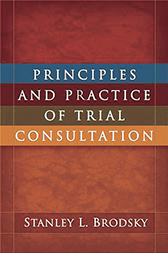Subscriber Benefit
As a subscriber you can listen to articles at work, in the car, or while you work out. Subscribe Now“Principles and Practice of Trial Consultation”
Dr. Stanley L. Brodsky has an impressive pedigree. He is professor of psychology at the University of Alabama in Tuscaloosa, where he coordinates the psychology-law PhD programs. He is the author of over 200 articles and 12 books, including “Testifying in Court,” “The Expert Expert Witness,” and “Coping with Cross-Examination.” He received the 2006 Distinguished Contributions to Psychology and Law Award from the American Psychology-Law Society and was a recipient of the Distinguished Contributions to Forensic Psychology Award from the American Academy of Forensic Psychology. In addition to his prestigious awards, he maintains a private practice in trial consulting and forensic psychology.

As a leader in the forensic psychology field, Brodsky provides relevant chapter titles in “Principles and Practice of Trial Consultation” discussing expert witnesses, changes of venue, witness preparation, and jury selection. He sheds light on the use of trial psychology in high-profile cases such as the Oklahoma City bombing and the Kobe Bryant cases. Other topics include capital murder, police brutality and racial bigotry.
The book’s strongest points are aimed at the trial consultant wanna-be and those interested in technical jury selection nuances. Brodsky advocates using supplemental jury questionnaires and his experiences with change of venue studies are replete. The criminal defense attorney will find chapter 8 on jury selection on Internet sex offenders quite interesting due to this rapidly growing area of litigation. The author also gives specific suggestions for voir dire in eminent domain and capital murder cases and uses many examples from his actual trials and depositions. There is a worthwhile section regarding deselecting authoritarian-type jurors.
Some of his best advice illustrates his use of the storytelling model and narrative which he calls the “story spine,” a technique originating from improvisational theater. The attorney and consultant collaboratively seek to fill in the case story by completing the following beginnings of sentences:
Once upon a time . . . .
And every day . . . .
But one day . . . .
And because of this [can be repeated up to three times] . . . .
And because of that . . . .
Until finally . . . .
So that forevermore . . . .
Working through this exercise helps both the trial attorney and consultant construct a story that enters into the sensory experiences of the jury and keeps the focus on the case theme.
Jury selection by attorneys is typically demographic, simplistic, and ill-developed from a social science perspective. Brodsky discusses Clarence Darrow’s oft-cited jury selection strategies used in the 1930s. It was common for defense attorneys in criminal cases and plaintiff attorneys in personal injury litigation to use their peremptory strikes to eliminate potential jurors who were Republican, rigid, right-wing, conservatively dressed, middle-class or wealthy, as well as being employed in occupations seen as impersonal, such as accountants and engineers. Today’s prosecuting attorneys in criminal cases and defense attorneys in civil cases often use similar stereotypes as they strike Democrats, liberals, casually dressed, working- or lower-class, apparently empathic persons who are employed in occupations seen as caring or helping, such as social workers, school counselors, and union organizers. Although this method for jury selection was once popular, it has since been discarded by experienced trial attorneys.
My criticisms of the book are relatively minor. First, the book advocates rating potential jurors on a number of psychographic and personality dimensions during voir dire. I have experimented with various rating scales and because they are so cumbersome, it is difficult to use them efficiently in the courtroom. Rating scales are nice but simply not practical in the courtroom. In voir dire it is hard enough to ask the right probe and listen to the answer. A second observer should be used to record the reply and then rank the responses accordingly. This drives home the point that you always need at least two people when selecting your jury; one asking questions and one evaluating the answers.
Nor does the text adequately address case strategy and presentation during opening and closing statements. Also absent is a discussion on a case theme development, a topic most important for trial lawyers. Most of the book is aimed at criminal trials and is best suited for students and beginning consultants rather than experienced trial attorneys and seasoned consultants. It could best be used as a part of a trial advocacy course in law school. He recognizes his limited experience with small research dynamics; consequently, this topic is underemphasized in the book.
All trial attorneys are looking for an edge when it comes to more efficient and successful case preparation and presentation. This book is a worthy read for trial attorneys looking to take a more jury-centered approach and beginning trial consultants. Brodsky’s book is a serious contribution in the growing field of trial consulting and trial work-up. He offers a practical, effective framework for those interested in gaining the edge in the trial setting. It is an easy read and user-friendly. The hardback book consists of 320 pages, lists for the reasonable price of $35 and is published by Guilford Press.•
__________
Rodney Nordstrom, Ph.D., J.D. is a trial consultant practicing in the Midwest, www.litsim.com. The opinions expressed in this column are the author’s
Please enable JavaScript to view this content.
